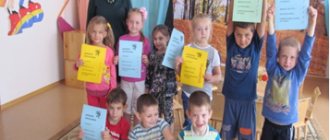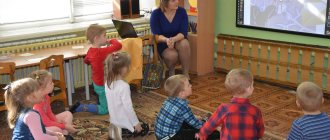Summary of a lesson on the development of coherent speech in the senior group
Summary of a lesson on the development of coherent speech in the senior group with presentation.
Topic: Retelling the fairy tale “The Postal Snail” Purpose: teaching a coherent, sequential retelling of the text based on graphic diagrams depicting the sequence of events. Objectives: 1. Educational:
- introduce the fairy tale “The Postal Snail”;
— learn to compose simple sentences, independently relying on graphic diagrams; - consolidate children’s ideas about the features of a fairy tale, its differences from a story. 2. Developmental:
- continue to develop the ability to listen carefully to a work of art, understand its meaning, and the ability to answer questions posed;
— develop basic mental operations: analysis, synthesis, generalization; - develop monologue speech; - improve coherent speech. 3. Educational:
- to create interest in speech activity;
independence, initiative in solving speech problems; - cultivate a value-based attitude towards literature. Preliminary work : reading fairy tales of other peoples, fairy tales of Russian writers, reading fiction about nature, looking at illustrations depicting flora and fauna, guessing riddles, didactic and outdoor games. Vocabulary work : herbivore, moisture-loving, postman, employees puzzled, valuable envelope, responsible employee. Methods and techniques : 1) Game-based: game motivation, physical education. 2) Verbal: conversations, reading fiction, explanations. 3) Visual: looking at illustrations, pictures. 4) Practical: working with reference diagrams. Equipment : slide show, illustrations for a fairy tale, graphic diagrams for a fairy tale, easel.
Progress of educational activities
1. Org. moment. Educator: - Look guys, we have guests today, let's say hello to them. — What’s your mood today? (children's answers) - I am also in a good, joyful mood today. Greeting game Gentle, kind girls! Strong, brave boys! Let's stand in a circle and let's all hold hands and smile joyfully at each other! Educator : - Let us smile and give our mood to everyone who surrounds us. 2. Motivational – orientation stage. Educator: - Today I invite you to go to the wonderful world of animals. Where we have to discover the most interesting secrets of animal life, their most unusual features and learn a lot of new things. And today we will talk... And about whom, you will find out if you guess my riddle: The house is always his own, Even goes to visit in it... There are horns, but not butts, Who sticks to the palm? (Snail) 1 slide - What does a snail eat?
Educator : - The snail is a herbivore. What does it mean? Herbivore means it eats grass and other plants and vegetables. Slide 2 - How does a snail eat?

Educator: - On the snail’s tongue, like on a file, there are hundreds of small teeth, with which the snail cuts and grinds food. Slide 3 - How does a snail live?
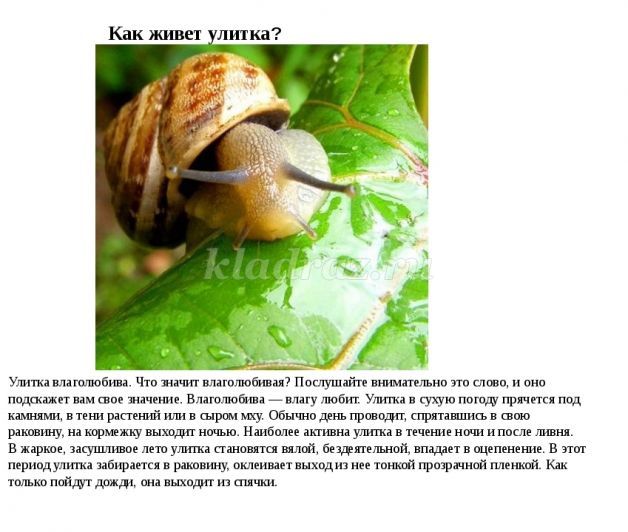
Educator: - Moisture-loving - this means she loves moisture. In dry weather, the snail hides under stones, in the shade of plants or in damp moss. Usually it spends the day hiding in its shell and comes out to feed at night. The snail is most active at night or after a rainstorm. Slide 4 - How does a snail move?
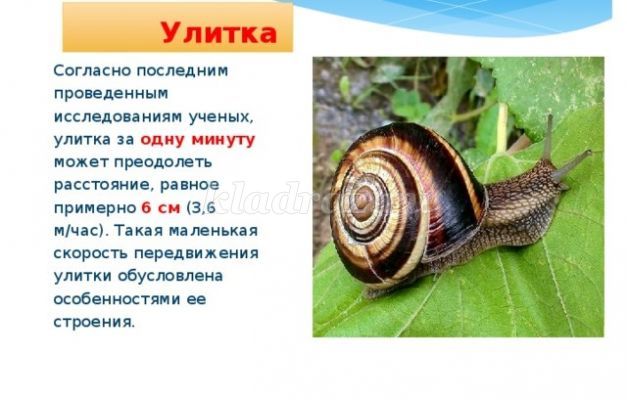
Educator: - The snail moves very slowly. Let’s all try to say the following words together: “Snail, crawl a little on your leg!” (Children say these words in chorus.) Look, while we were talking, the snail managed to crawl this distance. (Showing a segment 1.5 cm long). Slide 5 - Why does a snail need horns?
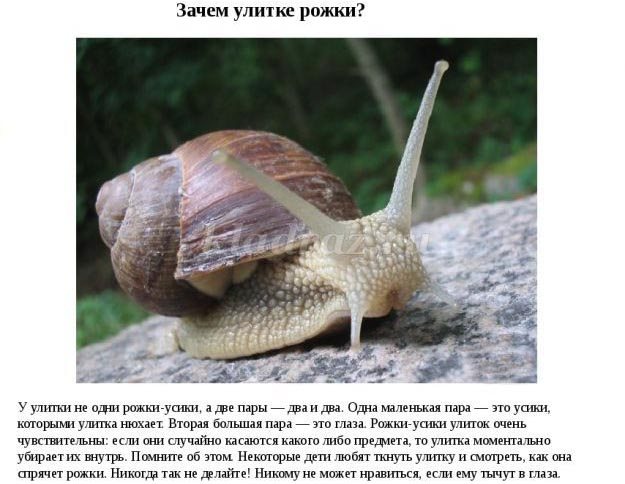
Educator: - A snail doesn’t just have horns, but one pair of horns, one pair of antennae. The antennae are small, the snail sniffs them. And the big horns are eyes. Both the horns and antennae of snails are very sensitive: if they accidentally touch any object, the snail immediately removes them inside. - That's how much we learned about the life of a snail. 3. Search stage Educator: - Guys, I want to tell you one interesting fairy tale, sit down more comfortably, take a listening position, so.... Reading the fairy tale “The Postal Snail.” More than anything else, the snail wanted to be a postman. “How wonderful it is,” she thought, “to spread good news and deliver valuable packages! Being a postman is the most interesting, most important and most joyful job!” But the postmen did not take the snail. You probably already guessed why: she crawled very slowly. - How will you spread the news? – laughed at the little girl at the post office. -Snails are not accepted as postmen. By the time you reach the recipient, the news will be outdated! This will no longer be news, but some kind of “old age”! Who will need them? “Eh,” sighed the snail, “why wasn’t I born a hare or a dove? Then no one would laugh, they would immediately accept it! I wish I could be as fast as them!” And she decided to train to become faster. Every morning the little girl woke up in the dark and went for a run. By dawn she was already on the treadmill. And by lunchtime she had crawled as much as two meters! Then two meters and a little more... But, alas, no matter how hard she tried, she remained a little fast, but still a snail. And she was still unsuited to work at the post office. - Give up this idea! - the hare shouted, adjusting his bag filled with letters and magazines as he ran. - You're just wasting your time. Even the fastest snail in the world cannot work as a postman! The snail understood that he was right, but she still couldn’t give up her dream. But one day a letter with a special note arrived in the mail. “Dear postman,” it was written on the envelope, “please be careful with this letter: it is full of tender feelings and may be damaged.” The postal employees were puzzled. Who can you trust to deliver such a valuable envelope? What if the hare remembers tender feelings? Or will they be damaged by shaking? - Snail! – the magpie suddenly remembered. - This is who can cope with such a task! True, she will not be able to deliver tender feelings quickly, but they will arrive safe and sound! And everyone agreed that it would be better this way. The snail tried really hard! And, of course, she did it! Now the little girl works at the post office and is very happy. When something needs to be delivered very carefully and accurately, they trust the snail. And everyone is very proud that they have such a responsible employee! (material from the Internet) Work on content. Educator: - Guys, did you listen to the fairy tale carefully? (Children's answers). - Let's talk to you about the content of this fairy tale. We answer with a full sentence. - Tell me, who is this fairy tale about? (Children's answers) - Who did the snail want to be? — Why did she like the profession of a postman? — Why didn’t the postal employees take the snail to work? - What efforts did the snail make to become fast? — What did the hare advise the snail? - What happened next? (Children’s answers) - What do you mean “the employees are puzzled”? (Children's answers) The teacher gives a definition of the expression. - “Puzzled” means to find yourself in a difficult situation, difficulty with an answer. - What did the magpie suggest? — What does “responsible employee” mean? The teacher gives a definition of the expression. - “Responsible worker” means one who does the job carefully, perfectly. Educator: - And now I invite you to a snail walk. Physical education A snail crawls along the path. It carries its house on its back. He crawls quietly, in no hurry, always looking around. Well, when she gets very tired and wants to rest, she can quickly curl up and turn into a round ball. Re-reading a fairy tale. Educator: - I will read the fairy tale to you again, you listen carefully, then we will retell it. And I will read the fairy tale based on the diagrams. The teacher displays diagrams while reading. 4. Practical stage. Retelling a fairy tale with the support of a diagram (you can use a presentation) Educator: - Guys, it’s difficult to retell such a big fairy tale alone. And if you break the text into parts, the tale can be retold by three people, even four people. Retelling a fairy tale based on diagrams (chain by part) . Educator: - Guys, please, who wants to tell you about the diagrams? What will you call your story? (calls 4 children to the easel, then 4 more children) - How would you title this fairy tale? OOD analysis. Educator: - What fairy tale did you get acquainted with today? — What do you remember most from the fairy tale? Individual analysis of children's activities in the classroom. 5. Reflective-evaluative stage. -Who was the hero of our lesson?
— What did you learn new there? - Next time we will introduce you to another good and instructive fairy tale. Presentation on the topic: Postal snail
We recommend watching:
Notes for a lesson on speech development in the senior group: Special purpose transport Notes for a lesson on speech development for children in the senior group of preschool educational institutions Notes for the development of speech in the senior group “Wild Animals of Russia” Notes for a lesson on speech development in the senior group. Nosov "Gardeners"
Similar articles:
Summary of a lesson on speech development in the senior group. Compiling a descriptive story based on a painting
Summary of a lesson on speech development in the senior group. Reading works of fiction
Summary of a lesson on speech development in the senior group. Retelling of a work of art. Charushin "Sparrow"
Summary of a lesson on ecology in the senior group of kindergarten on the topic “Man and Nature”
Lesson on emotional development in the senior group
Program tasks: consolidating the pronunciation of the sound [l*], developing the ability to correctly pronounce consonant sounds, articulating vowel sounds, determining the place of a sound in a word, sound analysis of words, consolidating the ability to compose sentences; development of auditory attention, memory, fine motor skills; fostering a sense of mutual assistance and responsibility for one’s actions.
Equipment: subject pictures (deer, bumblebee, heron, snail, frog), pencil cases (with red, green, blue circles), table mirrors, a hare toy, a spider toy, task cards, a fly agaric model with riddles, threads.
OOD progress.
I. Organizational moment. - Are you guys in a good mood today? If not everyone has it, then let's improve it! Psycho-gymnastics “Smile”: Let’s quickly gather in a circle, Let’s hold hands together. We will smile at each other! - Everyone is in a good mood now. I suggest going to visit the hare Stepashka in the forest. He invited us to his place today. Do you agree? - But he’s late for some reason. Has something really happened? (The teacher brings in a toy hare.) - Stepashka, hello. Tell me what happened? (The teacher speaks on behalf of the hare). - Silent people came to our forest. Everything in the forest froze: the birds stopped singing, the noise of the grass, the usual hubbub of the forest could not be heard. The forest is sleeping. He needs to be woken up. But this can be done by those who can speak well, know sounds well, and know how to compose sentences. Do you agree to help the forest? II. Main part. 1. Working with sounds. 1) Articulation. - Stepashka, we are ready to help you, but first we will prepare for such difficult tasks. - Guys, sit down at the tables, pull up the mirrors. Let's do exercises for the lips and tongue. (Children, each in front of their mirror, perform articulation exercises “Fence”, “Smile”, “Tube”, “Spatula”, “Clock”, “Swing”, “Horse”). - Now we are ready to go into the forest. 2) Isolation of sound among a number of others. - In front of us is the entrance to the forest, a dangerous guard sits at the entrance. (Place 2 tall indoor plants and hang a toy spider and a task card between them on threads). - Let's read and complete the tasks. No. 1 “Name all the vowel sounds.” No. 2 “What sound does the word forest begin with?” No. 3 “Clap your hands if you hear the sound [l*] among other sounds.” (For task No. 3, you can list any sounds: [s*], [l], [n*], [p*], [m], [d*], [k]). 3) Pure statements. - We can go into the forest. (The teacher breaks the threads.) - While we are walking along the path, repeat after me the simple sayings: Li-li-li - here we are in the forest. Va-va-va - and there is grass in the forest. If only there were mushrooms in the grass. Wee-wee-wee – don’t tear them all up. 4) Determining the place of sound in a word. - What an interesting mushroom! (The teacher shows a fly agaric with riddles.) - What is this mushroom called? — There is something written on his white peas. And next to the mushroom is card No. 2. We read the task: “Unspell the forest inhabitants by solving riddles and determining the place of the sound [l*] in the guess word.” a) We are green like grass, Our song: “Kva-kva.” (Frog is the first)
b) The tower is crawling, a rich, horned mistress is carrying it on its back. (Snail is the second)
c) He stands on one leg and looks intently into the water. Poking at random with its beak - Looking for frogs in the river. (Heron - fourth)
d) Flies - buzzes, Sits on a flower - is silent. And if he bites, then everyone screams. (Bumblebee is the last one)
d) Touching the grass with his hooves, a handsome man walks around the yard. He walks boldly and easily, with his horns spread wide. (Deer is second)
(As soon as the children guess the riddle, the teacher turns over the pictures on the typesetting canvas and clarifies the place of the sound [l*] in the word.) - Guys, you have revived the bumblebee, it will fly to the flowers and herbs and wake them up; revived the snail - it will wake up the insects; frog - all river inhabitants; heron - all birds; deer - all animals.
2. Work on word combinations. - What beautiful inhabitants of the forest! For example, people say not just a deer, but a red deer. And what kind of deer (frog, snail, bumblebee, heron)? (Children's approximate answers: deer - horned, tall, fast, handsome; snail - slow, small, crawling; frog - green, spotted, swamp; heron - white, winged, long-legged; bumblebee - striped, dangerous, buzzing).
3. Physical education minute. - Guys, look at the clearing we find ourselves in! Let's rest on it. We came out to the forest meadow, lifting our legs higher, through the bushes and hummocks, through the branches and stumps. Who walked so high - Didn’t stumble, didn’t fall!
4. Sound analysis of the word. — We approached the forest school. Here's another card. What is written here? Card No. 3 “Guess the word and give its analysis.” (Anagram card with words and pictures: Leaf-Needle-Dog-Watermelon). (Children guess the word.) - What sound does the word leaf begin with? — What sound does the word needle begin with? — What sound does the word dog begin with? — What sound does the word watermelon begin with? - What word did you get? - Let's sit down at the tables, take our pencil cases and turn over the cards with the word fox. - How many syllables are in a word? (Two) - How did you determine? (Clap, chin) - Name the first syllable. (Lee) - Name the second syllable. (Sa) - How many sounds are in a word? (4) - Name the first sound (second, third, fourth). [l*] – consonant, soft, green circle from a pencil case, [i] – vowel, red circle, [s] – consonant, hard, blue circle, [a] – vowel, red circle. (Children take turns pronouncing and laying out circles in the diagram.) - Well done, you coped with this task.
5. Work on proposals. - And here is card No. 4 “Make sentences with words.” - And with what words? There is a note here: “Define these words yourself by completing the sentences correctly.” a) Yellow is shining high in the sky... (sun) b) In the forest there are a lot of green, prickly... (firs) c) Wild berries are turning red in the grass... (strawberries) d) Ripe ones are hanging on an oak tree... (acorns) e) Sitting high on a tree goggle-eyed... (owl) f) A mustachioed one is crawling along a leaf... (beetle) - Now each of you needs to make up your own sentence with one of these pictures. (Children make sentences based on the selected picture.) - So we have completed all the tasks! - Let's tell the poem we taught about the forest. So that the pines, lindens, spruces do not get sick, so that they turn green, so that new forests rise to the skies. They are guarded by a friend - a forester, accompanied by the ringing and hubbub of birds! - Guys, who is the forester? Who can tell you about this profession? (If the children find it difficult, the teacher himself talks about the forester.)
III. Summing up. —Where and with whom did we travel today? — How did we help the forest? What did we do for this? — Which task was easy for whom to complete? - Stepashka, if anything else happens, come to us for help. We will definitely help. Or just come and visit us. We will be glad to see you again. Goodbye! Perspective. - And for you guys, there is a task, what you did today, draw and continue the album “Sound Staircase”.
